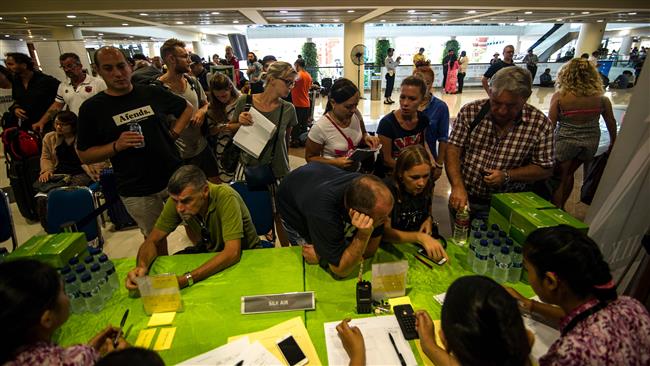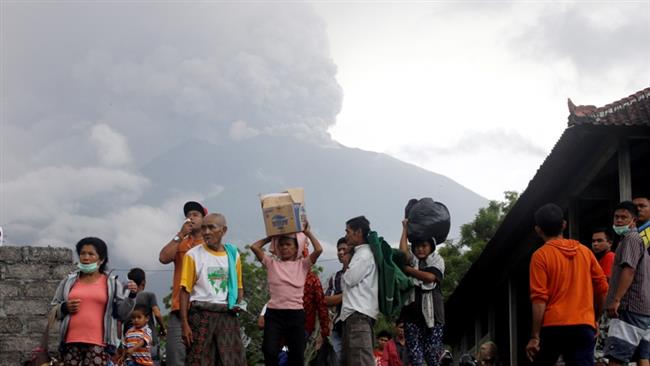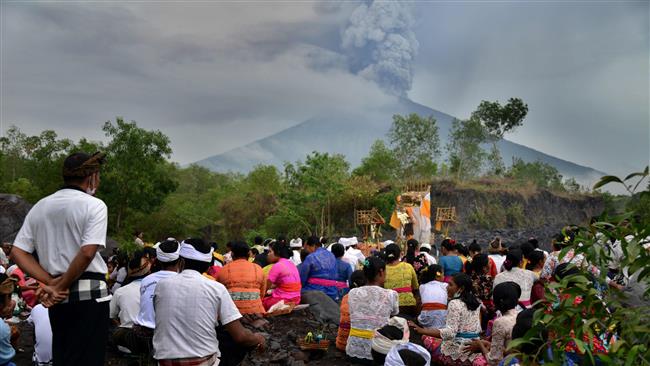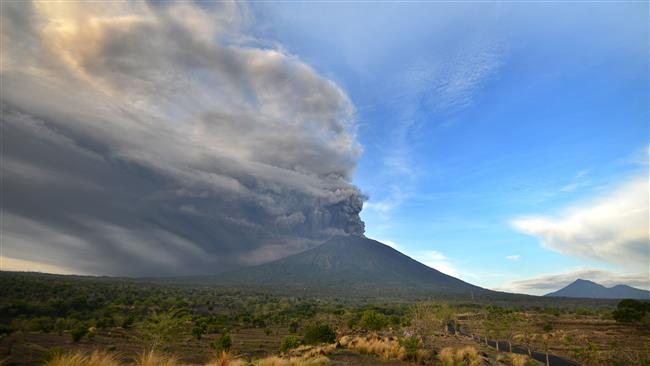Indonesia reopens Bali airport amid volcanic eruption
Bali airport reopened on Wednesday, Indonesian authorities said, two days after a volcanic eruption spread ash across the holiday island and forced its airport to close, stranding tourists and spurring evacuation efforts.
"Bali's international airport started operating normally," air traffic control provider AirNav said in a statement, adding that operations resumed at 2:28 p.m. (0628 GMT).
The reopening followed a downgrade in the authorities' aviation warning to "orange", one level below the most serious.
The decision to resume operations followed an emergency meeting at the airport, weighed up weather conditions, tests and data from AirNav and other groups, AirNav added.
The move raised hope for some of the more than 120,000 tourists stranded after a surge in activity at Mount Agung had grounded hundreds of flights since Monday, sparking travel chaos.

But airport officials cautioned that the only direct international gateway to the tropical island could be shuttered again if winds change direction and towering columns of smoke and ash pose a risk to flights.
"The airspace will be re-opened" at 3:00 pm local time (0700 GMT), Bali Ngurah Rai airport spokesman Arie Ahsanurrohim told AFP.
But "we are going to constantly monitor the situation on the ground," he added.
Singapore Airlines Ltd said it would resume flights between Singapore and Bali on Wednesday. Australia's Qantas Airways Ltd said it and budget arm Jetstar would run 16 flights to Australia on Thursday to ferry home 3,800 stranded customers.
A large plume of white and grey ash and smoke hovered above Agung on Wednesday, after night-time rain partially obscured a fiery glow at its peak over the last few days.
President Joko Widodo implored residents living in a zone around Agung deemed at risk to seek refuge in emergency centres, as winds sending an ash cloud southwest across the island once again halted flights.
Earlier, the transport ministry had said Bali's airport, the country's second biggest, would stay shut until at least 7 a.m. on Thursday (2300 GMT on Wednesday).
A spokesman for Bali's I Gusti Ngurah Rai International Airport said as many as 430 domestic and international flights had been disrupted on Wednesday by the closure of the airport, about 60 km (37 miles) away from Mount Agung.

Some stranded Chinese tourists appeared confused and upset over their predicament.
"All the Chinese people here feel (it is) dangerous (because of) the mountain," said Richard Cao. "You know in China we don't have such a mountain and it is the first time we faced this kind of problem."
Another said his group had received little help in efforts to leave, apart from being told to take a ferry to the neighboring island of Java and fly out via Surabaya.
"The travel agency left us alone," said the passenger, who declined to be identified. "They told us we need to go to Surabaya, but they couldn't even book the ticket, so why should we go to Surabaya?"
Officials of China's consulate in Bali met tour operators on Tuesday to thrash out steps to help stranded tourists, whom they had warned earlier of the risk of getting stuck.
The majority of Bali's tourists are Chinese, followed by Australians, Indians, British visitors and Japanese, according to the immigration office, which added that nearly 25,000 foreigners live in the small, Hindu-dominated island.
Mount Agung could produce a major eruption at any moment, officials have warned.
Tens of thousands have already fled their homes around the volcano -- which last erupted in 1963, killing around 1,600 people -- but as many as 100,000 will likely be forced to leave, disaster agency officials have said.

Experts said Agung's recent activity matches the build-up to the earlier disaster, which ejected enough debris -- about a billion tonnes -- to lower global average temperatures by around 0.3 degrees Celsius for roughly a year.
"Small eruptions have been happening continuously but there's still the possibility of a bigger, explosive eruption," said I Gede Suantika, a senior volcanologist at Indonesia's volcanology agency.
"Activity remains high and we are still on the highest alert level."
Authorities want residents in a radius of about 8 km to 10 km (5 miles to 6 miles) around the volcano to head for emergency centres, warning a larger eruption could be "imminent". But some are reluctant to leave homes and livestock unattended.
"Those in the 8- to 10-kilometer radius must truly take refuge for safety," President Widodo told reporters.

He also asked emergency services, military and officials to assist evacuees and help stranded tourists get home.
"There must not be any victims hit by the eruption," Widodo said.
Indonesia, the world's most active volcanic region, lies on the Pacific "Ring of Fire" where tectonic plates collide, causing frequent volcanic and seismic activities.
Last year, seven people were killed after Mt. Sinabung on the western island of Sumatra erupted. A 2014 eruption at Sinabung killed 16.
(Source: Agencies)
VIDEO | 444 days of ethnic cleansing
VIDEO | Bethlehem's Christmas dimmed by war, restrictions
Israel admits assassinating Hamas leader, vows to inflict same fate on Yemeni fighters, people
VIDEO | Yemeni forces repel US-British attack, down F-18 Jet
Iran’s capabilities vast; enemy’s ‘maximum pressure’ policies all failed miserably: Senior official
Iran’s economy grew 2.7% y/y in Sep quarter: CBI
VIDEO | Freelancers in Gaza strive to stay online amid genocide
Mikati demands Israel's withdrawal from south Lebanon














 This makes it easy to access the Press TV website
This makes it easy to access the Press TV website